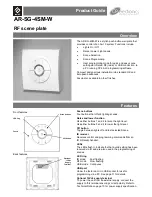MPC563XM Reference Manual, Rev. 1
Freescale Semiconductor
359
Preliminary—Subject to Change Without Notice
Even though misaligned non-burst transfers from internal masters are supported, the EBI naturally aligns
the accesses when it sends them out to the external bus, splitting them into multiple aligned accesses if
necessary. See
Section 13.5.2.13, “Misaligned Access Support
for these cases.
Natural alignment for the EBI means:
•
Byte access can have any address
•
16-bit access, address bit 31 must be 0
•
32-bit access, address bits 30-31 must be 0
•
For burst accesses of any size, address bits 29-31 must be 0
The EBI never generates a misaligned external access, so a multi-master system with two eSys MCUs can
never have a misaligned external access from one to the other. In the erroneous case that an
externally-initiated misaligned access does occur, the EBI errors the access (by asserting TEA externally)
and does not initiate the access on the internal bus.
The EBI requires that the portion of the data bus used for a transfer to/from a particular port size be fixed.
A 32-bit port must reside on data bus bits 0-31,and a 16-bit port must reside on bits 0-15.
In the following figures and tables the following convention is adopted:
•
The most significant byte of a 32-bit operand is OP0, and OP3 is the least significant byte.
•
The two bytes of a 16-bit operand are OP0 (most significant) and OP1, or OP2 (most significant)
and OP3, depending on the address of the access.
•
The single byte of a byte-length operand is OP0, OP1, OP2, or OP3, depending on the address of
the access.
Table 13-17. Transaction Sizes Supported by EBI
# Bytes (internal master)
# Bytes (external master)
1
1
2
2
4
4
3
1
1
Some misaligned access cases may result in 3-byte writes. These
cases are treated as power-of-2 sized requests by the EBI, using
WE_BE[0:3] to make sure only the appropriate 3 bytes get written.
8
16
2
2
Only supported for case of 32-bit internal AMBA data bus.
32
3
3
Only supported for case of 64-bit internal AMBA data bus.

















